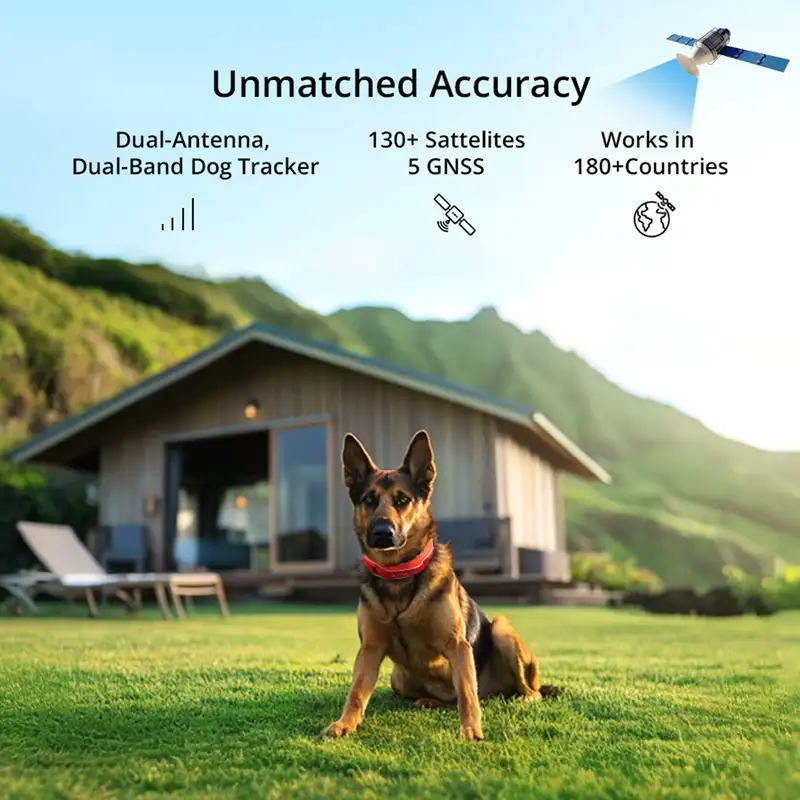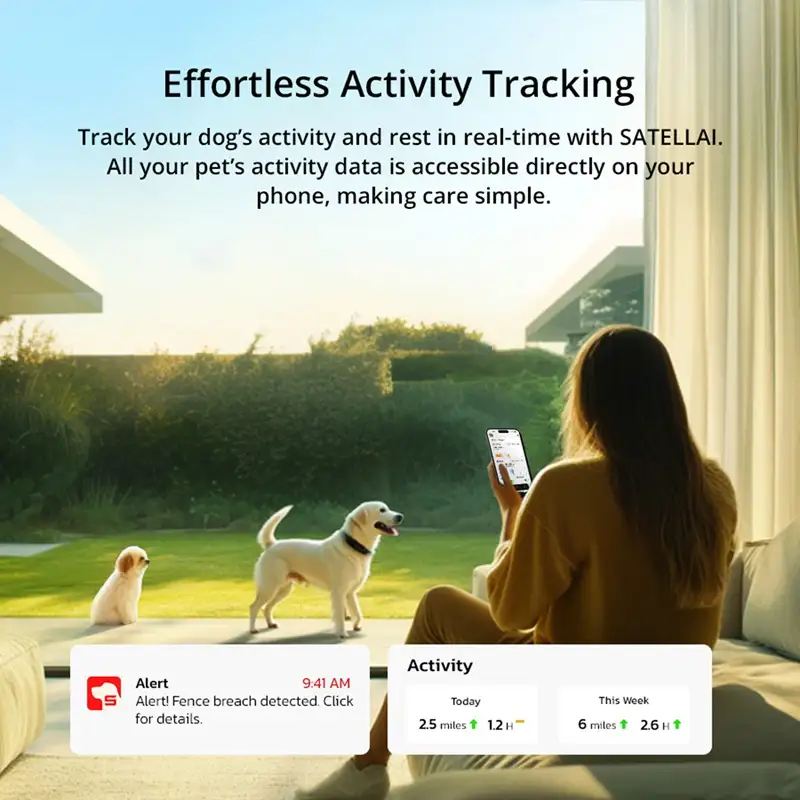Stay Informed: GPS Tracking Collars for Reliable Pet Location
Every pet owner knows the heart-stopping moment when their beloved companion slips out of sight during a walk or escapes through an open gate. In those precious minutes, worry turns into panic as you search frantically, calling their name and wondering how far they’ve wandered. GPS tracking collars have emerged as essential tools that transform these terrifying situations into manageable moments, providing real-time location data that helps reunite pets with their families quickly and efficiently.
Modern GPS tracking collars do more than simply pinpoint your pet’s location. They combine advanced satellite technology with thoughtful design to create devices that pets can wear comfortably throughout their daily activities.
The best tracking collars balance functionality with wearability, ensuring accurate positioning without causing irritation or restricting movement. As pet safety technology continues to evolve, understanding how these devices work and what features matter most empowers owners to make informed decisions that protect their four-legged family members while giving everyone greater freedom to explore the world together.
Understanding GPS Tracking Collars
GPS tracking collars are wearable devices that attach to your pet’s neck and use Global Positioning System technology to determine their precise location anywhere on Earth. These collars contain a GPS receiver that communicates with satellites orbiting the planet, calculating coordinates based on signals from multiple satellites simultaneously.
Once the device determines your pet’s position, it transmits this information through cellular networks or radio frequencies to your smartphone, tablet, or computer, allowing you to view their location on a digital map in real time. The technology operates continuously, updating location data at regular intervals—typically every few seconds to several minutes depending on the device settings.
Most modern GPS collars also incorporate additional sensors that detect movement patterns and activity levels, providing comprehensive insights into your pet’s behavior throughout the day. The collar’s tracking unit houses a battery, GPS antenna, and communication module within a compact, weatherproof casing designed to withstand the active lifestyle of dogs and cats. This combination of satellite positioning and wireless connectivity creates a reliable safety net that keeps you connected to your pet regardless of distance or terrain.

Key Features of GPS Dog Collars
The reliability of GPS dog collars stems from three fundamental features that work together to keep your pet safe and comfortable. Accurate tracking forms the foundation, with quality devices achieving precision within 10 to 30 feet under optimal conditions. This accuracy depends on the collar’s ability to connect with multiple satellites simultaneously and maintain strong cellular signals for data transmission.
Modern collars update location information frequently, with many offering customizable refresh rates that balance battery conservation with real-time monitoring needs. Ergonomic design ensures your dog actually wears the device without discomfort or resistance. The tracking unit sits positioned to avoid pressure points on your pet’s neck, while lightweight materials prevent strain during extended wear. Waterproof construction protects internal electronics from rain, swimming, and accidental submersion, allowing dogs to enjoy their normal activities without restrictions.
Adjustable fit accommodates dogs of varying sizes and breeds, with collar bands that expand or contract to maintain secure placement without being too tight. Quality collars feature multiple adjustment points and sizing options that prevent the device from rotating or sliding during active play. These three features—precision positioning, comfortable construction, and proper fit—transform a simple tracking device into a practical everyday tool that protects your pet while respecting their need for comfort and freedom of movement.

Benefits of Using GPS Tracking Collars
GPS tracking collars deliver peace of mind that fundamentally changes how pet owners experience daily life with their animals. Instead of constantly worrying about whether your dog might slip away during an off-leash moment or whether your cat has wandered too far from home, you gain the confidence that comes from knowing you can locate them within minutes.
This psychological relief extends beyond emergency situations—it transforms routine activities like hiking, camping, or visiting unfamiliar places into enjoyable experiences rather than anxiety-filled outings. Parents feel more comfortable allowing children to walk the family dog, and elderly owners gain independence knowing they have technological backup if their pet pulls away unexpectedly. Quick recovery capabilities mean that escaped pets return home in hours rather than days or weeks.
When a dog bolts after a squirrel or a gate accidentally stays open, every minute counts. GPS collars eliminate the guesswork from search efforts, directing you straight to your pet’s location instead of posting flyers and driving aimlessly through neighborhoods. This speed dramatically reduces the risks pets face when lost—avoiding traffic accidents, encounters with aggressive animals, exposure to extreme weather, and the trauma of prolonged separation.
Enhanced pet safety extends to health monitoring as well, with activity tracking features alerting you to unusual behavior patterns that might indicate injury or illness. Some collars establish virtual boundaries that trigger notifications when your pet leaves designated safe zones, preventing escapes before they become emergencies and allowing pets greater outdoor freedom within protected parameters.

Choosing the Right GPS Tracking Collar
Selecting the appropriate GPS dog collar requires evaluating three critical factors that directly impact long-term satisfaction and effectiveness. Durability determines whether your investment withstands the realities of pet ownership. Examine the collar’s construction materials, looking for reinforced stitching on fabric components and impact-resistant housings that protect internal electronics from drops and bumps. Check the waterproof rating—IPX7 or higher ensures protection during swimming and heavy rain, not just light splashes. Read user reviews specifically mentioning how collars held up after months of daily wear, paying attention to comments about cracked casings, frayed straps, or failing attachment points. Consider your dog’s activity level and environment; hunting dogs and trail companions need more rugged construction than apartment-dwelling pets with supervised outdoor time.
Battery life directly affects usability and determines how often you’ll need to recharge or replace batteries. Collars with continuous tracking typically last one to seven days per charge, while those using power-saving modes can extend operation to several weeks. Evaluate your monitoring needs realistically—constant updates drain batteries faster but provide more comprehensive tracking, while interval-based updates conserve power at the cost of slight delays in location information.
Look for devices with battery status notifications that alert you before power runs critically low, and consider whether the charging method fits your lifestyle. Some collars use proprietary charging docks while others accept standard USB cables, affecting convenience during travel. Companies like SATELLAI have developed systems that balance frequent location updates with extended battery performance, addressing one of the most common concerns pet owners face when choosing tracking technology.
Ease of use separates collars you’ll actually utilize from those that frustrate you into abandonment. Test the companion app before purchasing if possible, ensuring the interface displays information clearly and responds quickly to commands. The setup process should guide you through activation, boundary creation, and notification preferences without requiring technical expertise. Verify that the collar works with your smartphone’s operating system and that the service provider offers reliable cellular coverage in areas where your pet spends time. Consider whether the device requires subscription fees for cellular connectivity and whether those costs fit your budget long-term.
Tips for Using GPS Tracking Collars Effectively
Maximizing the effectiveness of your GPS tracking collar begins with maintaining current software and firmware. Manufacturers regularly release updates that improve accuracy, fix connectivity issues, and add new features.
Enable automatic updates in your companion app or check manually each month to ensure your device operates with the latest improvements. These updates often enhance satellite acquisition speed and refine location algorithms, directly impacting tracking precision when you need it most.
Testing your collar regularly prevents unpleasant surprises during actual emergencies. Conduct monthly test walks where you intentionally create distance between yourself and your pet while monitoring the tracking display.
Verify that location updates appear promptly and accurately, and confirm that boundary alerts trigger when your pet crosses virtual fence lines. Test the collar in various environments—open fields, wooded areas, and urban settings—since buildings and tree cover affect GPS signal strength differently.
Check that notifications reach your phone reliably and that you understand how to interpret the map interface quickly under stress. Monitoring your pet’s activity patterns provides valuable baseline data that helps you recognize abnormal behavior. Most GPS collars track daily movement, rest periods, and intensity levels.
Familiarize yourself with your pet’s typical activity signature so you’ll notice sudden changes that might indicate injury, illness, or distress. Set up custom alerts for unusual inactivity during normally active hours or unexpected movement during rest times. Regularly inspect the physical collar for wear, ensuring straps remain secure, attachment points show no cracks, and the device sits properly positioned.
Clean the collar monthly to prevent dirt buildup that might interfere with charging contacts or irritate your pet’s skin. Replace worn components promptly rather than waiting for complete failure, and always carry a backup traditional collar with identification tags as redundancy.
Common Concerns and Solutions
Privacy concerns rank among the most frequently cited hesitations when pet owners consider GPS tracking collars. The thought of location data being collected, stored, and potentially accessed by unauthorized parties creates legitimate anxiety.
Reputable manufacturers address these worries through encrypted data transmission that scrambles information as it travels from collar to server to your device, preventing interception by third parties. Look for companies that clearly outline their data policies, specifying that location information belongs exclusively to you and won’t be sold to advertisers or shared without explicit consent.
Enable password protection and two-factor authentication on your tracking app to add additional security layers. Review privacy settings regularly to ensure location sharing remains limited to trusted family members you’ve deliberately authorized. Choose manufacturers with transparent security practices and established reputations rather than unknown brands offering suspiciously low prices.
Battery life frustrations emerge when collars die at critical moments or require constant recharging that disrupts routines. Extend battery performance by adjusting update frequency based on actual needs—continuous tracking during hikes but hourly updates during supervised backyard time conserves power significantly.
Activate power-saving modes that reduce GPS polling when your pet remains stationary, since tracking a sleeping dog drains batteries unnecessarily. Establish charging routines that become habitual, such as plugging in the collar each evening when your pet settles for the night. Keep a spare charging cable in your car and another at work if you travel frequently with your pet.
Consider purchasing a second collar to rotate during charging periods for pets requiring constant monitoring. Some collars offer replaceable batteries rather than rechargeable units, providing extended field operation when electrical outlets aren’t accessible during camping trips or extended outdoor adventures.
Durability questions arise after seeing flimsy construction or reading reviews about collars failing within months. Protect your investment by selecting collars specifically rated for your dog’s size and activity level rather than choosing based solely on features or price.
Add protective covers or cases if your dog engages in particularly rough activities like hunting through dense brush or swimming in saltwater. Rinse the collar with fresh water after beach visits or muddy adventures to prevent corrosive buildup.
Store the collar properly when not in use rather than leaving it exposed to extreme temperatures in vehicles. Address minor damage immediately—a small crack can quickly worsen into complete failure if ignored.
Purchase from manufacturers offering solid warranties that cover defects and reasonable wear, and retain purchase documentation for warranty claims. Regular maintenance extends lifespan significantly, making even moderately priced collars cost-effective over years of reliable service.
Real-Life Examples and Testimonials
Sarah Martinez from Colorado credits her GPS collar with saving her German Shepherd’s life after he chased a deer during a mountain hike and disappeared into dense forest. Within fifteen minutes of activating the tracking app, she located him trapped in a ravine two miles from the trail, injured but alive.
The precise coordinates allowed rescue services to reach him quickly, preventing what could have been a tragic outcome. Mark Thompson, a Florida resident, discovered his elderly Labrador had squeezed through a fence gap he didn’t know existed. The collar’s boundary alert notified him immediately, and he found his dog within ten minutes, preventing exposure to midday heat that could have proven fatal for his senior pet.
Jennifer Lee shares how her tracking collar transformed her anxious rescue dog’s quality of life. Previously too fearful to allow off-leash time, she now confidently lets him explore fenced dog parks knowing she can locate him instantly if he bolts. The collar’s activity monitoring also revealed unusual lethargy that prompted a veterinary visit, catching an early infection before it became serious.
Pet owners consistently report that GPS collars provide freedom alongside security—dogs enjoy more outdoor adventures while families worry less. Many describe the collar as essential as vaccinations and regular vet checkups, a fundamental component of responsible pet ownership that pays dividends through prevented tragedies and enriched lives for both pets and their people.
Protecting Your Pet with GPS Technology
GPS tracking collars represent a practical investment in your pet’s safety, combining satellite technology with user-friendly design to create reliable location monitoring systems. These devices transform the frightening experience of a lost pet into a manageable situation, providing real-time coordinates that enable quick recovery and reduce the dangers associated with prolonged separation.
The key features—accurate positioning, comfortable construction, and durable materials—work together to create tools that pets can wear throughout their daily activities without restriction or discomfort. When selecting a collar, prioritize durability that matches your pet’s lifestyle, battery performance that supports your monitoring needs, and intuitive interfaces that function reliably during stressful moments.
Regular testing, software updates, and proper maintenance ensure your device performs optimally when emergencies arise. While concerns about privacy, battery drain, and device longevity exist, straightforward solutions address these issues effectively through encrypted data transmission, power-saving settings, and protective care routines. The testimonials from pet owners who’ve experienced successful recoveries and prevented tragedies demonstrate that GPS tracking collars deliver tangible benefits beyond theoretical peace of mind.
By understanding how these devices work and implementing them thoughtfully, you create an additional layer of protection that allows both you and your pet to enjoy greater freedom, knowing that technology stands ready to reunite you should unexpected separations occur.


